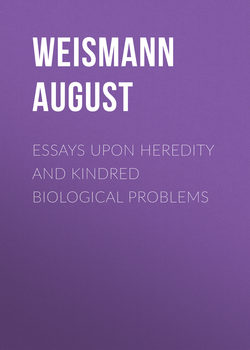Читать книгу Essays Upon Heredity and Kindred Biological Problems - Weismann August - Страница 11
I.
THE DURATION OF LIFE.
1881
APPENDIX
Note 3. The Duration of Life among Mature Insects
IV. Hemiptera
ОглавлениеAphis. Bonnet (‘Observations sur les Pucerons,’ Paris, 1745) had a parthenogenetic female of Aphis euonymi in his possession for thirty-one days, from its birth, during which time it brought forth ninety-five larvae. Gleichen kept a parthenogenetic female of Aphis mali fifteen to twenty-three days.
Aphis foliorum ulmi. The mother of a colony which leaves the egg in May is 2‴ long at the end of July: it therefore lives for at least two and a half months (De Geer, ‘Abhandlungen zur Geschichte der Insekten,’ 1783, III. p. 53).
Phylloxera vastatrix. The males are merely ephemeral sexual organisms, they have no proboscis and no alimentary canal, and die immediately after fertilizing the female.
Pemphigus terebinthi. The male as well as the female sexual individuals are wingless and without a proboscis; they cannot take food and consequently live but a short time,—far shorter than the parthenogenetic females of the same species (Derbès, ‘Note sur les aphides du pistachier térébinthe,’ Ann. des sci. nat., Tom. XVII, 1872).
Cicada. In spite of the numerous and laborious descriptions of the Cicadas which have appeared during the last two centuries, I can only find precise statements as to the duration of life in the mature insect in a single species. P. Kalm, writing upon the North American Cicada septemdecim, which sometimes appears in countless numbers, states that ‘six weeks after (such a swarm had been first seen) they had all disappeared.’ Hildreth puts the life of the female at from twenty to twenty-five days. This agrees with the fact that the Cicada lays many hundred eggs (Hildreth states a thousand); sixteen to twenty at a time being inserted into a hole which is bored in wood, so that the female takes some time to lay her eggs (Oken, ‘Naturgeschichte,’ 2ter Bd. 3te Abth. p. 1588 et seq.).
Acanthia lectularia. No observations have been made upon the bed bug from which the normal length of its life can be ascertained, but many statements tend to show that it is exceedingly long-lived, and this is advantageous for a parasite of which the food (and consequently growth and reproduction) is extremely precarious. They can endure starvation for an astonishingly long period, and can survive the most intense cold. Leunis (‘Zoologie,’ p. 659) mentions the case of a female which was shut up in a box and forgotten: after six months’ starvation it was found not only alive but surrounded by a circle of lively young ones. Göze found bugs in the hangings of an old bed which had not been used for six years: ‘they appeared white like paper.’ I have myself observed a similar case, in which the starving animals were quite transparent. De Geer placed some bugs in an unheated room in the cold winter of 1772, when the thermometer fell to -33°C: they passed the whole winter in a state of torpidity, but revived in the following May. (De Geer, Bd. III. p. 165, and Oken, ‘Naturgeschichte,’ 2ter Bd. 3te Abth. p. 1613.)
